 Romania (1899)
Romania (1899)
Romania’s only cruiser
The flagship of the Romanian navy, the protected cruiser Elisabeta was built in Armstrong, Elswick with a typical design for an export cruiser of the time. The term of “cruiser” seems derogatory compared to those of the 1930 generation, at 1300 tons and 73m long. But has quite a punch with her four 6-inch guns. She was modernized twice, was implicated in the Potemkine mutiny and served actively in WW1. She was eventually scrapped in the 1930s, after about a 45 years career, the first and last Romanian cruiser.
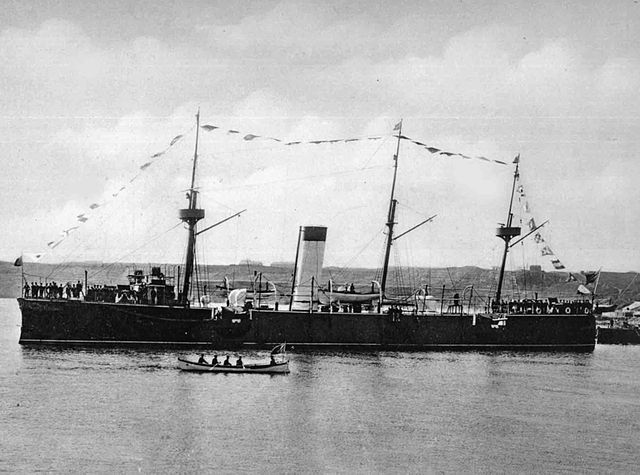
NMS Elisabeta after completion and before refit, in her initial state.
Development and construction of the Elisabeta
Romania became independent following the Russo-Turkish war of 1878. Although there has been a small riverine fleet on the Danube, no Romanian ships was able to defend the country’s eastern black sea coast. The port of Costanza was developed and turned to an arsenal, and the first ship to operate from there was the gunboat Grivita and a schoolship. A few years later the Romanian government planned a first naval extension and passed a naval law, securing fundings for a cruiser.
NMS Elisabeta (honoring Queen consort Elisabeth of Wied) Ordered in May 1887 at Armstrong Whitworth & Co Ltd. Specifications called for a rather modest export-type protected cruiser, with a classic configuration for the time with four 6-in guns in sponsons fore and aft and a complement of light QF guns and torpedo tubes. She was laid down at Elswick facility Yard number 517 on 17 May 1887, launched on 29 December 1887, Completed in September 1888 and Commissioned on October 1888.
Design of the Elisabeta
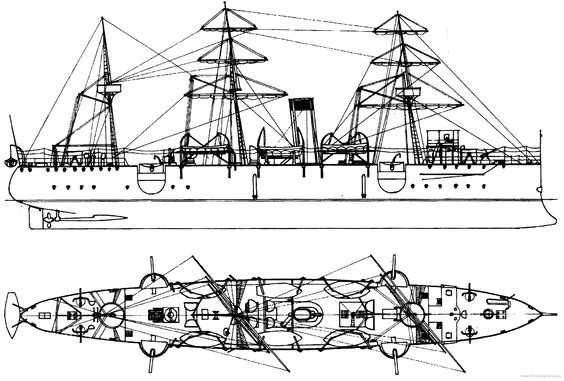
Blueprint (unknown origin) showing the classic shape of a 1880s cruiser designed by Philip Watts, with the armament in side sponsons and a battery of light guns, 18 knots and a sloped protective deck of 3.5 in. The ship was rigged as a three masts barque. The foremast and mizzen showed fighting tops. The hull was taller than wide, and had a relatively heavy sponsons battery, mostly for stability concerned with four guns.
Hull
Elisabeta displacement was 1,330 long tons (1,351 t), she measured 240 ft 10 in (73.4 m) by 33 ft 6 in (10.2 m) wide, and a 12 ft (3.7 m) draft. These were dimensions of torpedo cruisers rather than protected cruisers, although the latter were generally narrower and lighter. An analogy would be the Holwaldt’ converted Lima and Diogene, Peruvian 1881, 1700 tons cruisers which main battery was amidship in side sponsons. But it was small still. A contemporary also built in the same yard was the Italian Dogali (launched 1885) which was already 2050 tons, armed with six 6-in guns with the difference two pairs were placed fore and aft, and two in side sponsons. Another interesting take in the same generation of Armstrong cruisers were the SMS Panther class, 1557 tons (launched 1885) with a reduced masts and armed with two German 12cm/35 Krupp guns as main armament, also in sponsons.
Protection
It was limited to a protective deck with sloped sides: It was 1 to 2 in (25 to 50.8 mm) on the vertical plan, and thickened at 3-1/2 in (90 mm) on the slopes; There was however a conning tower a the front, with the navigation open bridge built above, which was 3-in thick (76 mm), and thicker Bulkheads of 4 in (102 mm). They protected the central citadel starting fore and aft of the main guns sponsons.
Powerplant
Elisabeta was given two vertical triple-expansion (VTE) steam engines. They drove each a single 2.95 m screw propeller. The Four cylindrical boilers, coal fired, had a total output of 3,000 indicated horsepower (2,237 kW) as designed. This was enough on paper for 16.5 knots (30.6 km/h; 19.0 mph). On 14 September 1888 sea trials took place and on paper Elisabeta was capable of 4,500 ihp (3,356 kW), reaching 17.5 knots (32.4 km/h; 20.1 mph). But she showed actually capable of making 4,714 ihp (3,515 kW), for a top speed of 18.3 knots (33.9 km/h; 21.1 mph) and 18.06 knots (33.45 km/h; 20.78 mph) on average with a total output of 4,271 ihp (3,185 kW) in normal draft, but without her main guns. Her three masts rigging was a backup, but seems to have been rarely used. She carried 322 long tons (327 t) of coal for her autonomy, sufficient in the black sea.
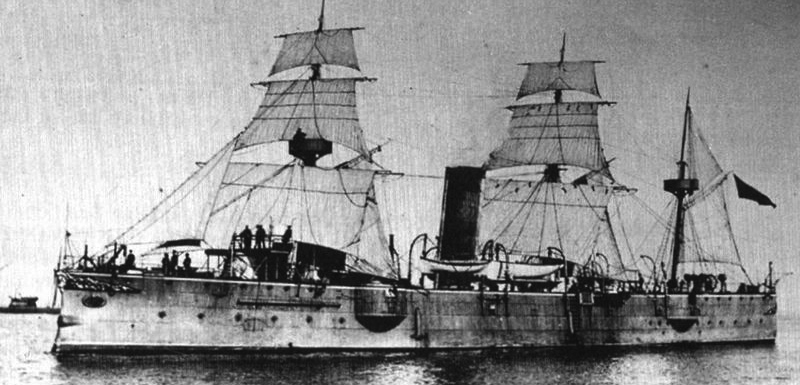
One of the rare photos of the Elisabeta under sails.
Armament
Armstrong made a proposal for the armament but this was rejected by the Romanian government, as German artillery was preferred. Mostly this decisions was motivated by maintenance and supplies rationale, as Krupp guns largely equipped the Romanian Army back then, which had the bulk of the national budget. Therefore the ships were launched and tested without their armament, and sailed in October 1888 to Galaţi shipyard in Romania, on the Danube.
There, they were equipped by the guns delivered by rail: Four single 15 cm (5.9 in) Krupp guns, four single QF 57 mm (2.2 in) Krupp guns, and four single 37 mm (1.5 in) guns. The origin of the four fixed additional 356 mm (14.0 in) torpedo tube is unknown.
The NMS Elisabeta in service 1889-1920
The final sea trials took place on 19 September 1888 after completion, without armament as it was said. She was commissioned in UK with her crew of 140 sailors and officers in late October 1888 and she sailed for Romania, arriving in the last week of December. She then sailed up the mouth of the Danube to Galaţi shipyards to receive her armament, one year after she had been launched on 29 December 1887.
In 1889 she started a session of summer training voyages around the Black Sea until 1890, leaving time for the crew to train with her recent armament. At the start of 1891 she sailed for five-month in the Mediterranean and represented Romania at the 1892 Columbus celebrations of Livorno, Barcelona and Lisbon. Her tour included France (Villefranche sur Mer, Antibes, Toulon), Italy (La Spezia, Livorno and Palermo) and Spain (Cádiz), Gibraltar and Malta.
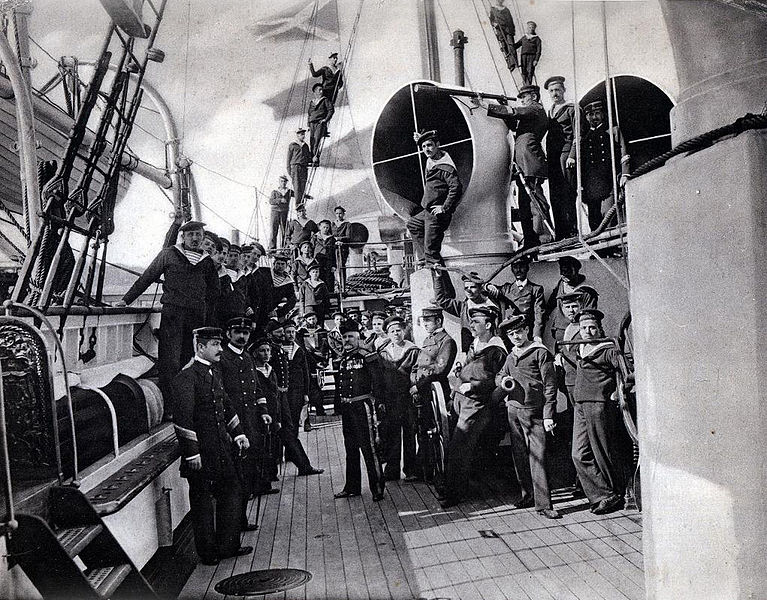
In 1894 she returned to the Black Sea for a short refit and resupply and returned in the longer Mediterranean cruise. The next year in 1895, she sailed for Kiel, her first visit to Germany, to participate in the opening celebration of the Kiel Canal. She went on and stopped at Stockholm, receiving the King of Sweden on board. 1896-97 years of service are not known;
In 1898 she started the first Romanian coastal survey before heading to Galaţi for a major refit which lasted between 1904 and 1905. Her sailing rig was reduced to two pole masts, keeping their military masts.
She was present when the Russian battleship Potemkin arrived in Constanța in July 1905. The mutineer tried to convince the authorities and crew to buy the Elisabeta (using their usual onboard gold reserve used to purchase coal and provisions in all ports), which was flatly declined. However no hostility was shown on any side. In all, the Romanian Cruiser stayed passive but fired two warning shots, a blank charge and an explosive charge at the torpedo boat Ismail, als hold by mutineers, when attempting to enter the port and join the Potemkine. She was driven off. The Russian battleship’s crew eventually asks for political asylum and the ship was interned.
In 1906, Elisabeta vwas present in Varna for a ceremony. She took part in naval exercises, carrying an infantry battalion for landing training. At the very end of 1906, the Romanian cruiser returned in harbour to be rearmed, this time, the main guns were removed and replaced by four French Saint-Chamond 120-millimeter (4.7 in), with double the rate of fire and longer range, and four 75 mm (3.0 in) guns in 1907. All the old QF 37-mm (1.5 in) guns were removed.
In 1912, Elisabeta was in Istanbul when the First Balkan War erupted. She landed 130 Romanian marines which secured the Romanian Legation, others the Romanian Consulate, and the remainder 100 took place in the outer sector of the city allotted to Romania for evacuation. Operation went smoothly and take several days, in which the Romanian sailors helped extinguishing a large fire. They also paid hommage and were at the funeral of Sefket Pasha. The Cruiser left Istanbul on 15 July 1913.
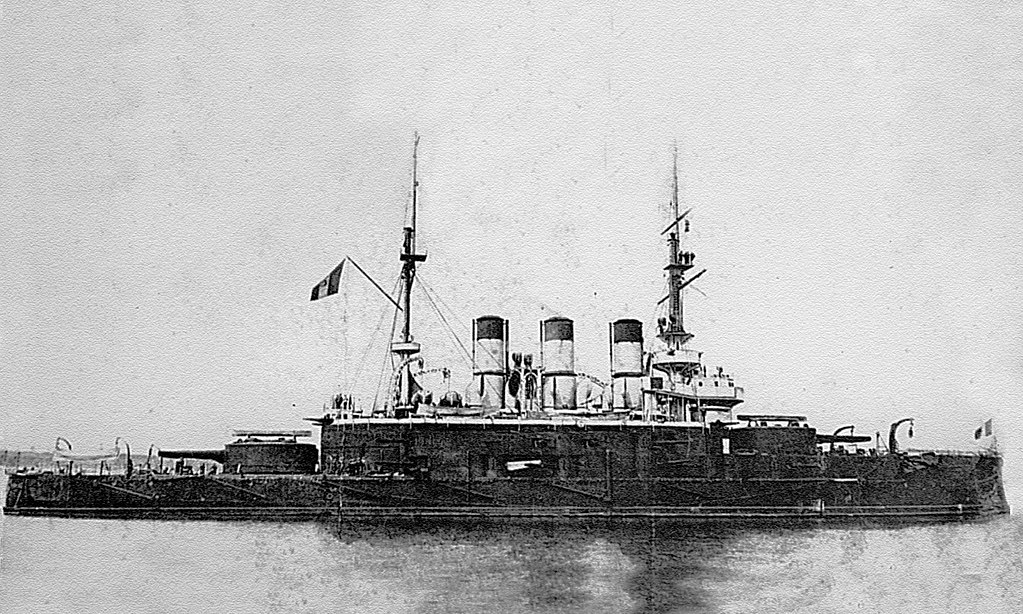
The Knyaz Potemkin-Tavricheskiy in 1905 at Constanta
NMS Elisabeta was at Sulina when the Second Balkan War started, and she defended the mouths of the Danube for all the conflict.
When the great War broke out, her main armament was landed, sent to form a coastal battery on the Danube. It was feared indeed an incursion of Austro-Hungarian river monitors. She remained in Sulina under Captain Nicolae Kirițescu for the duration of the war, mostly provided a fixed anti-aircraft defense with her four 75 mm guns, modified for AA fire. She still also had her four 356 mm (14 inch) torpedo tubes and four machine guns forclose defence.
In her AA role at Sulina she helped shooting down a Friedrichshafen FF.33 seaplane in the spring of 1917. The war ceased, treaty were passed in 1919-1920 and NMS Elisabeta was obsolete and it was decided to take her out of service. Officially she was written off in 1920, but stayed in use as a barracks ship at Galaţi, and later she steamed to Sulina for the same task. No longer maintained she was sold for scrap eventually in 1926, but not broken up yet, as she was again used as a barracks ship, this time up to 1929. Her scrapping’s date remained foggy, probably in the early 1930s.
By that time, the Romanian Navy has been thoroughly modernized, acquiring among others several destroyers which made the bulk of the navy. They took an active part in the operations in the black sea, backing up Operation Barbarossa and protecting convoys from and to Sevastopol and the Crimea.
Elisabeta class specifications |
|
| Dimensions | 73,4 x 10,2 x 3.7 m |
| Displacement | 1,330t, 1351 Lt FL |
| Crew | 140 |
| Propulsion | 2 shafts VTE, 4 boilers, 3,000 hp. |
| Speed | 18 knots. max. (33 km/h; 21 mph) |
| Range | Unknown |
| Armament (1914) | 4 x 120 mm, 4 x 75 mm, 4 TT 457 mm |
| Armor | Deck 25–89 mm, Conning tower 76 mm, bulkhead 102 mm. |
Read More/Src
Stănescu, Crăciunoiu, Marina română în primul război mondial, p. 33 & Modelism, 2000, p. 66
Georgescu, p. 166
Jane’s Fighting Ships WW I, Military Press, 1990, p. 294
Cristian Crăciunoiu, Romanian navy torpedo boats, Modelism, 2003, p. 24
Moșneagu, M. (2010), “Crucișătorul “Elisabeta” în campanie”, Document, 50
Brassey’s Annual
Conway’s all the world’s fighting ships 1865-1905
https://www.naval-encyclopedia.com/ww1/romanian-navy
http://www.navypedia.org/ships/romania/ro_cr_elisabeta.htm

 Latest Facebook Entry -
Latest Facebook Entry -  X(Tweeter) Naval Encyclopedia's deck archive
X(Tweeter) Naval Encyclopedia's deck archive Instagram (@navalencyc)
Instagram (@navalencyc)





 French Navy
French Navy Royal Navy
Royal Navy Russian Navy
Russian Navy Armada Espanola
Armada Espanola Austrian Navy
Austrian Navy K.u.K. Kriegsmarine
K.u.K. Kriegsmarine Dansk Marine
Dansk Marine Nautiko Hellenon
Nautiko Hellenon Koninklije Marine 1870
Koninklije Marine 1870 Marinha do Brasil
Marinha do Brasil Osmanlı Donanması
Osmanlı Donanması Marina Do Peru
Marina Do Peru Marinha do Portugal
Marinha do Portugal Regia Marina 1870
Regia Marina 1870 Nihhon Kaigun 1870
Nihhon Kaigun 1870 Preußische Marine 1870
Preußische Marine 1870 Russkiy Flot 1870
Russkiy Flot 1870 Svenska marinen
Svenska marinen Søværnet
Søværnet Union Navy
Union Navy Confederate Navy
Confederate Navy Armada de Argentina
Armada de Argentina Imperial Chinese Navy
Imperial Chinese Navy Marinha do Portugal
Marinha do Portugal Mexico
Mexico Kaiserliche Marine
Kaiserliche Marine 1898 US Navy
1898 US Navy Sovietskiy Flot
Sovietskiy Flot Royal Canadian Navy
Royal Canadian Navy Royal Australian Navy
Royal Australian Navy RNZN Fleet
RNZN Fleet Chinese Navy 1937
Chinese Navy 1937 Kriegsmarine
Kriegsmarine Chilean Navy
Chilean Navy Danish Navy
Danish Navy Finnish Navy
Finnish Navy Hellenic Navy
Hellenic Navy Polish Navy
Polish Navy Romanian Navy
Romanian Navy Turkish Navy
Turkish Navy Royal Yugoslav Navy
Royal Yugoslav Navy Royal Thai Navy
Royal Thai Navy Minor Navies
Minor Navies Albania
Albania Austria
Austria Belgium
Belgium Columbia
Columbia Costa Rica
Costa Rica Cuba
Cuba Czechoslovakia
Czechoslovakia Dominican Republic
Dominican Republic Haiti
Haiti Hungary
Hungary Honduras
Honduras Estonia
Estonia Iceland
Iceland Eire
Eire Equador
Equador Iran
Iran Iraq
Iraq Latvia
Latvia Liberia
Liberia Lithuania
Lithuania Mandchukuo
Mandchukuo Morocco
Morocco Nicaragua
Nicaragua Persia
Persia San Salvador
San Salvador Sarawak
Sarawak Uruguay
Uruguay Venezuela
Venezuela Zanzibar
Zanzibar Warsaw Pact Navies
Warsaw Pact Navies Bulgaria
Bulgaria Hungary
Hungary

 Bundesmarine
Bundesmarine Dutch Navy
Dutch Navy Hellenic Navy
Hellenic Navy Marina Militare
Marina Militare Yugoslav Navy
Yugoslav Navy Chinese Navy
Chinese Navy Indian Navy
Indian Navy Indonesian Navy
Indonesian Navy JMSDF
JMSDF North Korean Navy
North Korean Navy Pakistani Navy
Pakistani Navy Philippines Navy
Philippines Navy ROKN
ROKN Rep. of Singapore Navy
Rep. of Singapore Navy Taiwanese Navy
Taiwanese Navy IDF Navy
IDF Navy Saudi Navy
Saudi Navy Royal New Zealand Navy
Royal New Zealand Navy Egyptian Navy
Egyptian Navy South African Navy
South African Navy






























 Ukrainian Navy
Ukrainian Navy dbodesign
dbodesign